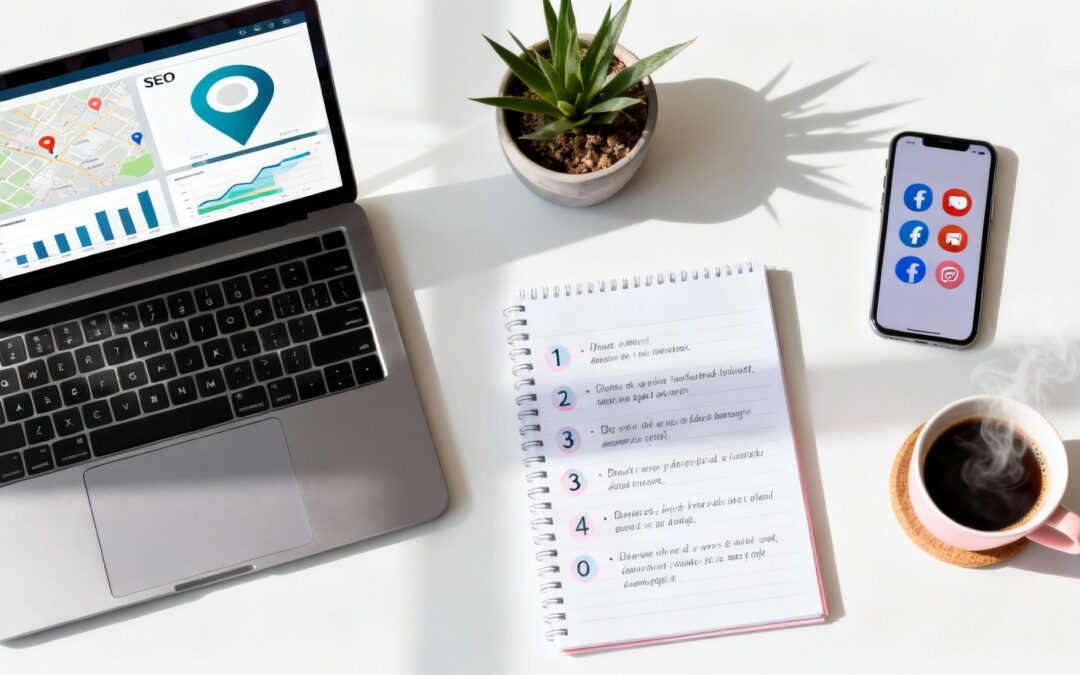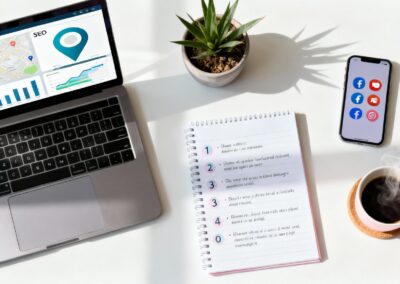In a competitive marketplace, having an excellent product or service is just the starting point. To truly succeed, small businesses must be strategic and efficient with their marketing, ensuring every effort counts. The challenge isn't a lack of options; it's knowing where to focus your limited time and resources for the greatest return. This is where many entrepreneurs get stuck, overwhelmed by endless advice and complex tools.
The good news is that impactful digital marketing doesn't require a Fortune 500 budget. It requires a clear, actionable plan. This guide is designed to be that plan. We’ve filtered out the noise to bring you a prioritized list of the most effective digital marketing tips for small businesses. Forget vague theories and generic advice. Instead, you'll find a practical playbook filled with specific strategies you can implement immediately to attract more customers and drive real growth.
We will cover ten essential pillars of a strong marketing foundation. You will learn how to dominate local search results, build a community on social media, create content that converts, and track your performance with data. Each tip is broken down into straightforward, actionable steps, complete with examples tailored for local entrepreneurs and startups. This is not about doing everything at once. It's about doing the right things, right now. Let’s build your marketing engine and start achieving sustainable results today.
1. Leverage Google My Business for Local SEO
For any small business serving a specific geographic area, a fully optimized Google Business Profile (GBP) is non-negotiable. This free platform is the digital equivalent of a storefront sign and welcome mat all rolled into one. It’s what allows your business to appear in Google Maps and the valuable "Local Pack" in search results, often placing you above organic website listings. When a potential customer searches for "plumber near me" or "best coffee shop in [Your Town]," a strong GBP is your best chance to be their first impression.
Why It's a Top Priority
Your GBP directly impacts your visibility for high-intent local searches. It’s a powerful trust signal, displaying verified business information, customer reviews, photos, and direct contact options. A well-maintained profile makes it incredibly easy for customers to find you, call you, visit your website, or get directions, which shortens the path from discovery to purchase. This is one of the most effective, zero-cost digital marketing tips for small businesses looking to capture local customers.
How to Implement It Effectively
Getting started is simple, but optimization is key to standing out. Treat your Google Business Profile as an active marketing channel, not a one-time setup.
- Complete Every Section: Fill out every available field, including services, products, accessibility information, and attributes. The more information you provide, the better Google understands your business and can match it to relevant searches.
- Use High-Quality Photos and Videos: Regularly upload clear images of your storefront, products, team, and happy customers. This visually communicates what you offer and builds authenticity.
- Actively Manage Reviews: Respond to every review, both positive and negative. Thank customers for positive feedback and address negative comments professionally, offering solutions. This shows you value customer feedback.
- Publish Weekly Posts: Use the "Posts" feature to share updates, promotions, events, or new products. This signals to Google that your business is active and provides fresh content for potential customers.
By making profile management a consistent part of your routine, you directly boost your local search ranking and customer engagement. To dive deeper into this topic, explore these additional strategies on how to improve local SEO.
2. Develop a Content Marketing Strategy
Content marketing is the practice of creating and sharing valuable, relevant, and consistent content to attract and engage a specific audience. Instead of directly pitching your products or services, you provide genuinely useful information that solves your audience's problems. For small businesses, this could be blog posts, how-to videos, or informative social media updates that build trust and establish you as an expert in your field. This approach draws customers in naturally, making it a cornerstone of modern digital marketing.

Why It's a Top Priority
Content marketing builds a long-term relationship with your audience. It drives organic traffic to your website, improves your SEO rankings over time, and nurtures potential customers without a hard sell. By consistently providing value, you create brand loyalty and become the go-to resource when a customer is ready to make a purchase. For small businesses with limited budgets, creating quality content is a cost-effective way to compete with larger players by focusing on a specific niche and audience need.
How to Implement It Effectively
A successful content strategy is planned and purposeful, not random. The goal is to create assets that serve your audience and your business at the same time.
- Identify Your Audience's Problems: Use keyword research and listen to customer questions to understand what they are searching for. Your content should provide the answers. A local landscaper, for example, could write a blog post about the "best drought-resistant plants for [Your City]."
- Create a Content Calendar: Plan your content in advance to ensure consistency. A simple calendar outlining topics, formats, and publishing dates helps you stay on track and avoid scrambling for ideas. This is a critical organizational tool for any small business.
- Focus on Quality Over Quantity: One well-researched, helpful blog post or video is more valuable than five generic, rushed ones. Focus on creating content that genuinely solves a problem or answers a question thoroughly.
- Promote and Repurpose Your Content: Don't just publish and forget. Share your content across your social media channels and in your email newsletter. You can also repurpose a single blog post into multiple social media graphics, a short video, or a podcast segment to maximize its reach.
3. Build Email Marketing Campaigns
Email marketing is the process of sending targeted commercial messages to a list of subscribers who have opted in to hear from you. Unlike social media, where algorithms control your reach, email provides a direct line of communication to your audience. For small businesses, it offers one of the highest returns on investment in digital marketing, allowing you to nurture leads, promote products, and build lasting customer relationships in a personalized way.
Why It's a Top Priority
While newer channels emerge, email remains a cornerstone of effective digital marketing. It's a channel you own completely; your email list is an asset that isn't subject to the whims of a third-party platform. It allows for precise segmentation, ensuring the right message reaches the right person at the right time. From abandoned cart reminders for an e-commerce store to weekly newsletters from a local cafe, email marketing drives conversions and fosters a loyal community around your brand.
How to Implement It Effectively
A successful email strategy is built on trust and value, not just sales pitches. Focus on delivering content that your subscribers genuinely want to receive.
- Build Your List Organically: Never buy an email list. Instead, offer a valuable incentive, like a discount, a free guide, or exclusive content, in exchange for an email address on your website. This ensures your subscribers are genuinely interested.
- Segment Your Audience: Group your subscribers based on their interests, location, or past purchase behavior. This allows you to send highly relevant content, such as sending a special offer for a product a customer previously viewed.
- Write Compelling Subject Lines: Your subject line is your first and only chance to earn an open. Make it intriguing, clear, and urgent without being spammy. Test different options to see what resonates with your audience.
- Provide Consistent Value: Your emails shouldn't always be about selling. Share helpful tips, company news, or entertaining content to keep your audience engaged. A fitness studio, for example, could send weekly workout tips alongside its class schedule.
- Include a Clear Call-to-Action (CTA): Every email should have a purpose. Use clear, action-oriented buttons like "Shop Now," "Learn More," or "Book Your Spot" to guide subscribers to the next step.
4. Utilize Social Media Marketing
Social media marketing uses platforms like Facebook, Instagram, LinkedIn, and TikTok to build brand awareness, engage with customers, and drive sales. For a small business, it’s a powerful, cost-effective tool for connecting directly with a target audience, building a loyal community, and humanizing a brand. Instead of just broadcasting advertisements, social media allows you to create a two-way conversation, turning passive followers into active brand advocates.

Why It's a Top Priority
In today's digital landscape, a social media presence is expected. It's where your customers spend their time, discover new products, and seek recommendations. Having an active, engaging profile builds trust and credibility. It provides a direct line for customer service, feedback, and relationship-building that traditional marketing channels cannot match. This makes it one of the most essential digital marketing tips for small businesses aiming to foster genuine connections and drive long-term growth.
How to Implement It Effectively
Success on social media requires a strategic approach, not just random posting. Consistency and authenticity are your most valuable assets. Focus your efforts on a few key actions to maximize your impact.
- Choose Platforms Wisely: Don’t try to be everywhere. Focus on the 2-3 platforms where your target audience is most active. A local restaurant will likely thrive on Instagram and Facebook, while a B2B consultant should prioritize LinkedIn.
- Post with Purpose and Consistency: Aim for a consistent schedule, such as 3-5 times per week. Mix your content: share educational tips, behind-the-scenes glimpses, customer testimonials, and promotional offers to keep your feed interesting and valuable.
- Engage Authentically: Social media is a conversation. Respond to comments, answer direct messages promptly, and interact with posts from your followers and other local businesses. This engagement shows you care and builds a strong community.
- Leverage Platform-Specific Features: Use Instagram Stories for daily updates, create short-form videos for TikTok and Reels, and use Facebook Events to promote in-store happenings. For specific strategies to boost your video content on platforms like TikTok, refer to a comprehensive guide on How to Increase TikTok Video Views.
5. Optimize Website for SEO (Search Engine Optimization)
Beyond your local presence, your website itself must be a powerful engine for attracting customers. Search Engine Optimization (SEO) is the practice of refining your website's content and structure to rank higher in search engine results for relevant keywords. For a small business, this means getting in front of customers who are actively searching for the products or services you offer, driving consistent, qualified traffic without paying for every single click. It’s a long-term strategy that builds a sustainable source of leads and sales.
Why It's a Top Priority
Effective SEO transforms your website from a simple digital brochure into a 24/7 lead generation tool. Ranking high in organic search results builds credibility and trust with potential customers, as they often see organic listings as more authentic than paid ads. Unlike paid advertising, where traffic stops when you stop paying, the results of good SEO compound over time. This makes it one of the most cost-effective digital marketing tips for small businesses aiming for scalable growth.
How to Implement It Effectively
SEO can seem complex, but focusing on the fundamentals will yield significant results. Treat your website as a living resource that needs consistent attention to perform well in search.
- Conduct Keyword Research: Use tools to identify the specific terms and phrases your target audience uses to find businesses like yours. Focus on "long-tail" keywords (e.g., "emergency roof repair in Austin") which are less competitive and have higher conversion intent.
- Create High-Quality Content: Develop informative blog posts, service pages, and guides that answer your customers' most pressing questions. Aim for comprehensive content (1,500+ words where appropriate) that establishes your business as an expert.
- Optimize On-Page Elements: Ensure every page has a unique, keyword-focused title tag and meta description. Use header tags (H1, H2, H3) to structure your content logically, making it easy for both search engines and readers to understand.
- Focus on Technical Health: Your website must be fast, mobile-friendly, and secure (using HTTPS). These factors directly impact user experience and search rankings.
By methodically improving these elements, you build a strong foundation for search visibility. For a more detailed guide, check out these actionable SEO quick wins you can implement today.
6. Create Strategic Partnerships and Collaborations
No business is an island. Strategic partnerships involve teaming up with complementary, non-competing businesses to expand your reach, share resources, and build credibility. For a small business, this means gaining access to a new, relevant audience at a fraction of the cost of traditional advertising. It’s a powerful way to leverage the trust another brand has already built with its customers.
Why It's a Top Priority
Partnerships provide an instant boost in reach and authority. When a trusted business or influencer recommends you, their audience is far more likely to listen than they would to a standard ad. This "borrowed trust" is invaluable. It’s one of the most organic digital marketing tips for small businesses because it taps into existing community relationships to generate warm leads and genuine brand affinity, creating a win-win for both partners and their customers.
How to Implement It Effectively
Successful collaborations are built on mutual value and clear communication. The goal is to create something that benefits both your business and your partner’s audience, not just a one-sided promotion.
- Identify Aligned Partners: Look for businesses that share your target audience but don't directly compete. A local wedding photographer could partner with a florist, or a fitness trainer could collaborate with a healthy meal prep service.
- Start with a Clear Offer: Don't just ask to "collaborate." Propose a specific idea, like a joint webinar, a co-branded giveaway on social media, or a bundled service package. Show them how it will benefit their business and their customers.
- Define Expectations: Put everything in a simple agreement. Outline who is responsible for what, how you will promote the collaboration, and how you will measure success. Clarity prevents misunderstandings down the line.
- Cross-Promote Authentically: Promote the partnership across all your channels, from email to social media. Encourage your partner to do the same. The key is to present the collaboration as a genuine value-add for your audience.
7. Implement Video Marketing
Video has become the dominant content format online, capturing attention and driving engagement in a way that static text and images simply cannot. For small businesses, implementing video marketing means creating and sharing video content to promote your brand, educate your audience, or showcase your products and services. It’s about telling your story in a dynamic, visual medium that builds connection and trust with potential customers.

Why It's a Top Priority
Video content is highly shareable, incredibly engaging, and favored by social media algorithms. Platforms like TikTok, Instagram Reels, and YouTube have made video consumption a daily habit for billions. For a small business, this translates to higher brand recall, increased website traffic, and better conversion rates. Whether it’s a product tutorial, a behind-the-scenes look at your team, or a client testimonial, video makes your brand more human and relatable, which is a key advantage in a crowded market.
How to Implement It Effectively
Getting started with video doesn't require a Hollywood budget. Your smartphone is a powerful enough tool to begin creating high-quality content that resonates with your audience.
- Start Small and Simple: You don't need expensive equipment. Use your smartphone to shoot short clips. Focus on good lighting and clear audio. Create brief, snappy videos (under 60 seconds) for social media platforms like TikTok and Instagram Reels.
- Show, Don't Just Tell: Create content that provides value. A local contractor can show a before-and-after project transformation, a boutique can showcase new arrivals on a model, and a tech consultant can record a quick screen-share tutorial.
- Optimize for How People Watch: Add captions to every video. Most users watch videos with the sound off, and captions ensure your message gets across while also making your content accessible.
- Include a Clear Call-to-Action (CTA): Tell your viewers what to do next. Whether it's "visit our website," "shop the link in bio," or "book a consultation," a clear CTA turns viewers into potential customers.
By integrating video into your strategy, you tap into one of the most powerful digital marketing tips for small businesses, allowing you to connect with your audience on a deeper, more memorable level.
8. Use Data Analytics and Performance Tracking
Marketing without data is like driving with your eyes closed. You might be moving, but you have no idea if it’s in the right direction. Data analytics is the process of measuring, collecting, and analyzing marketing performance to understand what’s working and what isn’t. For a small business, this practice is crucial for making informed decisions, optimizing campaigns, and stretching every dollar of your marketing budget for maximum return.
Why It's a Top Priority
Analytics transforms guesswork into a strategic, evidence-based approach. By tracking key performance indicators (KPIs), you can identify which channels are driving the most traffic, which content resonates with your audience, and where potential customers are dropping off in their journey. This insight allows you to double down on effective tactics and cut wasteful spending, a critical advantage for any small business. Implementing performance tracking is one of the most powerful digital marketing tips for small businesses aiming for sustainable growth.
How to Implement It Effectively
You don't need to be a data scientist to get started. The key is to focus on metrics that directly impact your business goals and to build a consistent review process.
- Set Up Foundational Tools: The first step is to install Google Analytics on your website. This free tool provides invaluable information about your visitors, their behavior, and how they found you. Also, set up Google Search Console to monitor your site's search performance.
- Define Your Key Metrics: Don't get lost in a sea of data. Identify a few KPIs that align with your goals. For an e-commerce store, this might be conversion rate; for a local service, it could be phone calls from your website or form submissions.
- Track Campaign Performance: Use UTM parameters for your social media, email, and ad campaigns. These simple tags allow you to see exactly which links are driving traffic and conversions in Google Analytics, giving you a clear picture of each campaign's ROI.
- Establish a Review Cadence: Set aside time weekly or bi-weekly to review your data. Look for trends, identify top-performing content or channels, and spot any potential issues like a sudden drop in traffic. This regular check-in ensures you can adapt your strategy quickly.
9. Develop a PPC (Pay-Per-Click) Advertising Strategy
While organic strategies build long-term momentum, Pay-Per-Click (PPC) advertising offers immediate visibility and traffic. Platforms like Google Ads and social media ads allow you to place your business directly in front of a highly targeted audience, and you only pay when someone clicks your ad. For a small business needing to generate leads or sales quickly, PPC can be a powerful engine for growth, delivering measurable results from a controlled budget.
Why It's a Top Priority
PPC provides a level of speed and precision that organic marketing can't match. You can launch a campaign and start seeing traffic within hours. This makes it an invaluable tool for promoting special offers, entering new markets, or competing against larger businesses in search results. The ability to target users based on demographics, interests, location, and specific search terms ensures your marketing dollars are spent reaching people who are most likely to convert.
How to Implement It Effectively
A successful PPC strategy isn't about spending the most money; it's about being the most relevant. A thoughtful, data-driven approach will maximize your return on investment.
- Start Small and Test: You don't need a massive budget. Begin with a modest daily spend to test different keywords, ad copy, and audience targeting. This allows you to learn what works without significant financial risk.
- Focus on High-Intent Keywords: Target keywords that signal a user is ready to buy. For example, a local plumber should prioritize "emergency plumber near me" over a general term like "plumbing."
- Write Compelling Ad Copy: Your ad must grab attention and clearly state your value proposition. Include a strong call-to-action (CTA) like "Get a Free Quote Today" or "Shop Our Sale Now."
- Use Negative Keywords: Actively build a list of negative keywords to prevent your ads from showing for irrelevant searches. This simple step saves money and improves the quality of your traffic.
- Track Conversions, Not Just Clicks: A click is meaningless if it doesn't lead to a desired action. Set up conversion tracking to measure what truly matters, whether it's a form submission, a phone call, or a sale.
10. Build Customer Loyalty and Retention Programs
Acquiring a new customer can cost five times more than retaining an existing one. For this reason, a loyalty and retention program isn't just a nice-to-have; it's a strategic necessity. These programs reward repeat business and foster ongoing engagement through incentives, exclusive offers, and personalized experiences. Think of it as a formal way of saying "thank you" to your best customers, which in turn encourages them to keep coming back and increases their lifetime value.
Why It's a Top Priority
Loyalty programs transform one-time buyers into brand advocates. In a competitive market, where customers have endless choices, giving them a compelling reason to choose you repeatedly is crucial. Retained customers tend to spend more over time and are more likely to refer friends and family. This creates a sustainable growth loop, making it one of the most cost-effective digital marketing tips for small businesses focused on long-term success.
How to Implement It Effectively
A successful program is simple, valuable, and makes customers feel special. It doesn't need to be as complicated as big-box retail programs; even simple gestures can build powerful loyalty.
- Keep It Simple: Whether it's a digital punch card or a points-based system, the mechanics should be easy to understand. If customers can't quickly grasp how to earn and redeem rewards, they won't participate.
- Offer Meaningful Rewards: The incentives must be valuable to your audience. This could be a free product, a significant discount, early access to new items, or exclusive content.
- Personalize the Experience: Use customer data to offer personalized rewards. Acknowledge milestones like birthdays or anniversaries with a special bonus to show you value their individual relationship with your brand.
- Communicate Consistently: Use email and social media to remind customers of their loyalty status, available rewards, and exclusive program benefits. Keep the program top-of-mind to encourage repeat purchases.
By focusing on making your best customers feel appreciated, you build a foundation of loyalty that competitors will find difficult to break. For a deeper look into this strategy, explore these insights on maximizing customer retention with a small business loyalty program.
10-Point Digital Marketing Strategy Comparison
| Item | 🔄 Implementation Complexity | ⚡ Resource Requirements | 📊 Expected Outcomes | 💡 Ideal Use Cases | ⭐ Key Advantages |
|---|---|---|---|---|---|
| Leverage Google My Business for Local SEO | Low — simple setup, regular updates | Low — time for updates, photos; free tool | 📊 Improved local search visibility, more foot traffic; ⭐⭐⭐ | Local brick‑and‑mortar and service-area businesses | ⭐ Free, review management, map placement |
| Develop a Content Marketing Strategy | Medium‑High — planning, creation, distribution | Medium‑High — content creation time, skills or hires | 📊 Authority and organic traffic growth (months); ⭐⭐⭐⭐ | Businesses seeking SEO, thought leadership, lead gen | ⭐ Builds trust, sustainable organic growth |
| Build Email Marketing Campaigns | Medium — list building, segmentation, automation | Low‑Medium — email platform, content time | 📊 High ROI, strong retention and repeat sales; ⭐⭐⭐⭐ | E‑commerce, subscriptions, customer nurture | ⭐ Direct, measurable, highly personalizable |
| Utilize Social Media Marketing | Medium — platform strategies and community management | Low‑Medium — content creation, optional ad spend | 📊 Brand awareness and engagement; variable conversions; ⭐⭐⭐ | B2C brands, local businesses, community building | ⭐ Real‑time engagement, targeted ads, viral potential |
| Optimize Website for SEO | High — technical, content, and link work | Medium‑High — tools, expertise, ongoing maintenance | 📊 Sustainable high‑intent organic traffic (3–6+ months); ⭐⭐⭐⭐ | Businesses aiming for long‑term organic visibility | ⭐ Long‑term traffic, credibility, better UX |
| Create Strategic Partnerships and Collaborations | Medium — find partners, negotiate agreements | Low‑Medium — time for outreach, shared resources | 📊 Expanded reach and shared costs; ⭐⭐⭐ | Cross‑promotions, complementary service collaborations | ⭐ Access to new audiences, cost sharing |
| Implement Video Marketing | Medium‑High — production and editing workflows | Medium‑High — equipment, software, skills/time | 📊 Very high engagement and improved conversions; ⭐⭐⭐⭐ | Product demos, tutorials, social growth campaigns | ⭐ High engagement and shareability |
| Use Data Analytics and Performance Tracking | Medium — setup tracking and interpret data | Low‑Medium — many affordable/free tools, analyst time | 📊 Improved ROI through optimization and clear KPIs; ⭐⭐⭐⭐ | Any channel/campaign needing measurement and optimization | ⭐ Data‑driven decisions, identifies bottlenecks |
| Develop a PPC Advertising Strategy | Medium — campaign setup and ongoing optimization | Medium‑High — ad budget, management expertise | 📊 Immediate traffic and targeted conversions; ⭐⭐⭐ | Time‑sensitive campaigns, competitive keywords, fast leads | ⭐ Fast visibility, highly targetable, scalable |
| Build Customer Loyalty and Retention Programs | Medium — program design and integration | Medium — rewards costs, platform integration | 📊 Increased customer lifetime value and repeat purchases; ⭐⭐⭐⭐ | Repeat‑purchase businesses, subscription models | ⭐ Higher CLTV, referrals, long‑term revenue uplift |
Putting These Tips Into Action for Your Business
Navigating the world of digital marketing can feel like trying to drink from a firehose. With countless platforms, strategies, and acronyms, it's easy to feel overwhelmed and unsure where to begin. The ten practical tips we've explored in this guide are designed to cut through that noise, providing a clear and actionable roadmap for small businesses ready to make a significant impact online. From mastering your local presence with Google Business Profile to building lasting relationships through strategic email campaigns and engaging social media, you now have a powerful toolkit at your disposal.
The journey to effective digital marketing is not a sprint; it is a marathon built on consistent, intentional effort. The most successful entrepreneurs don't try to implement everything at once. Instead, they identify their most pressing business need and choose one or two strategies to master first. Is your immediate goal to drive foot traffic to your storefront? Then pouring your energy into your Google Business Profile and local SEO is the perfect starting point. Are you focused on building a loyal community around your brand? A dedicated content and social media strategy will be your most valuable asset.
From Knowledge to Action: Your Next Steps
The true value of these digital marketing tips for small businesses lies not in reading them, but in their application. To transform this information into tangible results, you need a plan. Let’s break down how you can start implementing these ideas today, moving from passive learning to active growth.
- Step 1: Conduct a Mini-Audit. Take an honest look at your current marketing efforts. Where are the biggest gaps? Are you completely absent on social media? Is your website outdated and not optimized for search? Identifying your weakest link is the first step toward strengthening your overall strategy.
- Step 2: Prioritize Your Top 1-2 Goals. Based on your audit, what is the most important outcome you need right now? More leads? Increased brand awareness? Higher customer retention? Choose one primary goal and a secondary one. This focus will prevent you from spreading your resources too thin.
- Step 3: Create a 30-Day Action Plan. Don't think about the next year; think about the next month. If your goal is to improve local SEO, your 30-day plan might include fully optimizing your GBP listing, gathering 10 new customer reviews, and publishing one location-specific blog post. Break down the big strategy into small, manageable weekly tasks.
- Step 4: Measure Everything. You cannot improve what you do not measure. Set up Google Analytics to track website traffic, monitor your social media engagement rates, and pay close attention to your email open and click-through rates. These metrics are not just numbers; they are direct feedback from your audience, telling you what’s working and what isn’t.
The Power of Consistent, Strategic Execution
Remember, progress over perfection is the mantra for small business marketing. Your first video might not be flawless, and your initial PPC campaign might need adjustments. That’s not only okay; it’s expected. The key is to start, learn, and adapt. Each piece of content you publish, every email you send, and every analytic report you review provides valuable data that will make your next effort more effective.
By consistently applying these foundational digital marketing tips for small businesses, you are not just chasing clicks or followers. You are building a resilient, scalable marketing engine that will attract new customers, foster loyalty with existing ones, and ultimately drive sustainable growth. You are investing in your business's future, ensuring it not only survives but thrives in an increasingly digital marketplace. This strategic approach transforms marketing from an expense into your most powerful investment.
Feeling ready to implement these strategies but want an expert partner to accelerate your growth? The team at Digital Lotus Marketing specializes in creating and executing tailored digital marketing plans that deliver measurable results for small businesses. We handle the complexities of SEO, content, and advertising so you can focus on what you do best: running your business.






